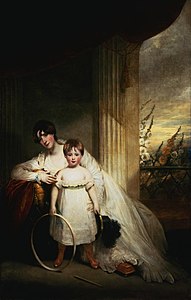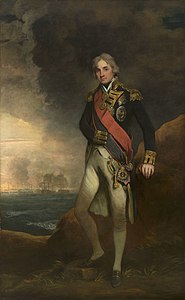|
John Hoppner
John Hoppner RA (4 April 1758 – 23 January 1810[1]) was an English portrait painter, much influenced by Reynolds, who achieved fame as a brilliant colourist. Early life  Hoppner was born in Whitechapel, London, the son of German parents – his mother was one of the German attendants at the royal palace.[2] King George showed a fatherly interest and patronage of the young boy that gave rise to rumours, quite unfounded,[2] that he may have been his illegitimate son. Hoppner became a chorister at the royal chapel, but, showing strong inclination for art, in 1775 he entered the Royal Academy. In 1778 he took a silver medal for drawing from life, and in 1782 the Academy's highest award, the gold medal for historical painting, his subject being King Lear.[2] CareerHoppner first exhibited at the Royal Academy in 1780. His earliest love was for landscape, but necessity obliged him to turn to the more lucrative business of portrait painting. At once successful, he had throughout life the most fashionable and wealthy sitters, and was the greatest rival to the growing attraction of Thomas Lawrence. He rarely attempted ideal subjects, though a Sleeping Venus, Belisarius, Jupiter and Io, a Bacchante and Cupid and Psyche are recorded among his works. The Prince of Wales visited him especially often, and many of his finest portraits were hung in the state apartments at St James's Palace, notably those of the prince himself, the Duke and Duchess of York, Lord Rodney and Lord Nelson. His other sitters included Sir Walter Scott, the Duke of Wellington, Henry Bartle Frere and Sir George Beaumont.[2] According to the 1911 edition of the Encyclopædia Britannica:[2]
In 1803 he published A Series of Portraits of Ladies,[2] engraved after his paintings by Charles Wilkin,[3] and in 1805 a volume of translations of Eastern tales into English verse.[2] Unusually Hoppner painted the background and perhaps more of a full-length portrait of Charlotte, Countess Talbot by Thomas Gainsborough in 1788, the year in which Gainsborough died. It is now in the Dunedin Public Art Gallery. Personal lifeHe married Phoebe Wright, the daughter of American-born sculptor Patience Wright. They had five children, although little is known about the youngest:
DeathIn his later years Hoppner suffered from a chronic disease of the liver. He died on 23 January 1810.[2] Gallery
References
Further reading
External linksWikimedia Commons has media related to John Hoppner.
|
||||||||||||||























